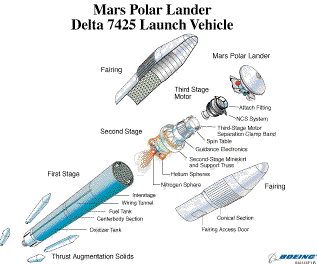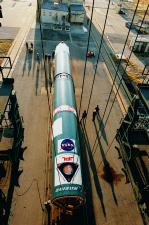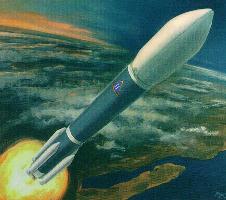

The Mars Climate Orbiter and Mars Polar Lander will be launched on a variant of Boeing's Delta II launch vehicle known as a Delta 7425. The vehicle is similar to the 7925, a more powerful version of the Delta II used for NASA's Near Earth Asteroid Rendezvous (NEAR), Mars Pathfinder and Mars Global Surveyor missions, except that it uses four strap-on solid rocket boosters instead of nine. Mars Surveyor 98 Delta II Launch Vehicle
Each of the four solid rocket motors is 1 meter (3.28 feet) in diameter and 13 meters (42.6 feet) long; each contains 11,765 kilograms (25,937 pounds) of hydroxyl-terminated polybutadiene (HTPB) propellant and provides an average thrust of 446,023 newtons (100,270 pounds) at sea level. The casings on the solid rocket motors are made of lightweight graphite epoxy.

Diagram Of The Delta II Launch VehicleThe main body of the first stage is 2.4 meters (8 feet) in diameter and 26.1 meters (85.6 feet) long. It is powered by an RS-27A engine, which uses 96,160 kilograms (212,000 pounds) of RP-1 (rocket propellant 1, a highly refined kerosene) and liquid oxygen as its fuel and oxidizer.

The Delta II Rocket Arriving at Kennedy Space Center
October 30, 1998The second stage is 2.4 meters (8 feet) in diameter and 6 meters (19.7 feet) long, and is powered by an AJ10-118K engine. The propellant is 5,900 kilograms (13,000 pounds) of Aerozine 50 (A-50), a mixture of hydrazine and unsymmetrical dimethyl hydrazine (UDMH), and nitrogen tetroxide as the oxidizer. This engine is restartable, and will perform two separate burns during the launch.
The third and final stage of the Delta 7425 is a Thiokol Star 48B booster, the same final stage used in the 1996 launch of Mars Global Surveyor. The Star 48B measures 2.12 meters (84 inches) long and 1.2 meters (4 feet) wide. Its motor carries solid propellant composed of a mixture of aluminum, ammonium perchlorate and hydroxyl-terminated polybutadiene (HTPB) solid propellant.

The Mars Climate Orbiter and Mars Polar Lander Lander are each separately launched on McDonnell Douglas Delta II 7425 launch vehicles, procured via the MedLight Launch Vehicle contract. Each launch vehicle is equipped with 4 thrust augmentation solids and use the 9.5 ft. fairing. The upper stage in each case consists of a spin stabilized Star 48 with a Nutation Control System and a yo-yo despin device. For both vehicles, a single, near instantaneous launch window is baselined for each day in the launch period, using a 95 degree flight azimuth and short coast ascent trajectories.

A minimum probability of second stage commanded shutdown (PCS) of 95% is required by the Project. The Delta II 7425 capability for the Orbiter is 643 kg wet mass at a C3 of 11.263 km2/s2 and 95% PCS. The current estimated maximum C3 is 11.19 km2/s2 at the start of the launch period. The Lander wet mass at launch must not exceed 615 kg, a figure dictated by the maximum mass allowed at atmospheric entry and landing, and the need to carry the New Millenium Microprobes. The performance of the Delta II 7425 accommodates this requirement with PCS greater than 99.7% across the entire launch period.

Launch vehicle operational constraints limit the time between Orbiter and Lander launch to be no less than 9 days, assuming the use of two launch pads. This has been accommodated by separating the end of the Orbiter launch period and the start of the Lander launch period by 9 days.
History of the Delta Rocket
The Delta II is a medium capacity expendable launch vehicle derived from the Delta family of rockets built and launched since 1960.
Its roots go back to the days immediately following the launch of Sputnik in 1957, when the company modified its U.S. Air Force intermediate-range ballistic missile, the Thor, into a booster for Earth-orbiting satellites.
NASA's first satellite launch attempt on board Delta was Echo I in May 1960. Although it was not successful, the launch of NASA's Echo IA satellite August 12, 1960, started Delta on its way to becoming "NASA's workhorse."
Until the early 1980s the Delta increased in size and capability, serving as NASA's primary launch vehicle for boosting communications, weather, scientific and planetary exploration satellites into orbit.
After 24 years, Delta production came to a halt as NASA planned to launch subsequent satellites on board the Space Shuttle. However, in January 1986 the tragic explosion of the shuttle Challenger brought an announcement from President Ronald Reagan that shuttles would no longer carry commercial payloads, opening the way for the return of Delta.
A major contract to produce and launch 20 medium launch vehicles for the U. S. Air Force, beginning in 1989, brought the Delta production line back into full swing -- this time with the larger, more powerful Delta II. The U.S. Air Force contract was the catalyst necessary to market Delta commercially.
Through the years Delta became larger, more advanced and capable of carrying heavier satellites into orbit. Initially the rocket lifted 100 pounds to low-Earth orbit (LEO); the Delta II model 7425 with a 9.5-ft fairing boosts approximately 2,490 pounds (1,129 kg) to geosynchronous transfer orbit (GTO) and 6,970 pounds (3,162 kg) to low-Earth orbit (LEO).
Design changes include a 12-foot extension in the first-stage tanks increasing propellant capacity, an improved main engine, adoption of advanced electronics and guidance systems, and development of upper stage and satellite payload. Currently, customers are offered three fairing sizes ranging from eight feet to 10 feet in diameter.
During its lifespan variations of two main engines, both built by Rocketdyne, a division of The Boeing Company, have carried Delta aloft. From 1960 to 1974 the MB-3 powered the rocket; since then the RS-27 has been the main engine. Three strap-on solid rocket boosters were added to the Delta in 1964, and later the number increased to six. Currently the rocket can use up to nine solid rocket motors.
| Home | Mars Polar Lander | Deep Space 2 Microprobes | Mars Climate Orbiter |
| Welcome | Mailing List | Links | Credits |
For questions or comments on this website please refer to our list of contacts.